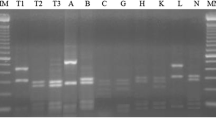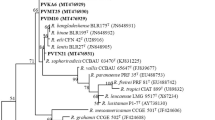Abstract
One hundred and sixty isolates of rhizobia were sampled from the root nodules of common bean (Phaseolus vulgaris L.) cultivated in Tunisian soil samples originating from three geographically distinct fields. Plasmid profiling was used as a primary method to rapidly screen the isolates, and then 38 plasmid types were recorded among the 160 isolates. A sample representing the majority of plasmid types was chosen for further characterization by restriction fragment length polymorphism (RFLP) analysis of genomic DNA using chromosomal and symbiotic gene probes, and by their ability to nodulate a potential alternative host, Leucaena leucocephala. One third of the isolates showed a high similarity to Rhizobium gallicum isolated from common bean in France, another third showed the same characteristics as the R. etli-R. leguminosarum group, while the remaining isolates could not be related to any of the five species nodulating bean. When reexamined for nodulation, some of these isolates, showing similarities to R. tropici and Agrobacterium with respect to colony morphology and growth in different media, failed to nodulate their original host. The R. gallicum-like isolates, R. etli-like isolates, and R. leguminosarum-like isolates were recovered from regions where bean is frequently grown, while in fields which had not been cultivated with beans for at least the 10 previous years, solely unrecognized taxa of ineffective isolates were recovered. We detected variations in the symbiotic regions, but certain pSym RFLP patterns for nifH were conserved between Tunisian, French, and Austrian populations of bean rhizobia. Evaluation of symbiotic effectiveness showed that R. gallicum-like isolates and R. etli-like isolates were effective, whereas some R. leguminosarum-like isolates were ineffective. Furthermore, effective isolates were also found among the unrecognized taxa.
Similar content being viewed by others
Author information
Authors and Affiliations
Additional information
Received: 10 March 1998
Rights and permissions
About this article
Cite this article
Mhamdi, R., Jebara, M., Aouani, M. et al. Genotypic diversity and symbiotic effectiveness of rhizobia isolated from root nodules of Phaseolus vulgaris L. grown in Tunisian soils. Biol Fertil Soils 28, 313–320 (1999). https://doi.org/10.1007/s003740050499
Issue Date:
DOI: https://doi.org/10.1007/s003740050499




